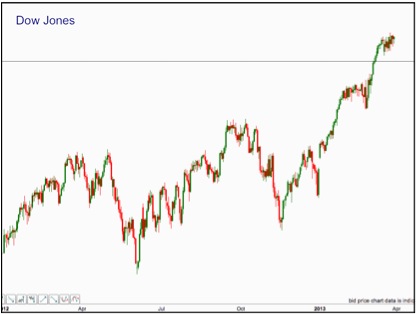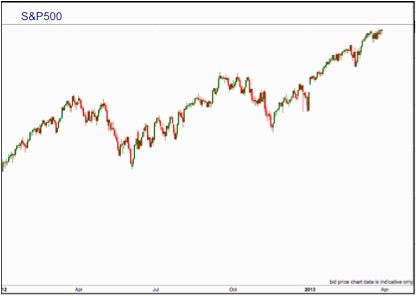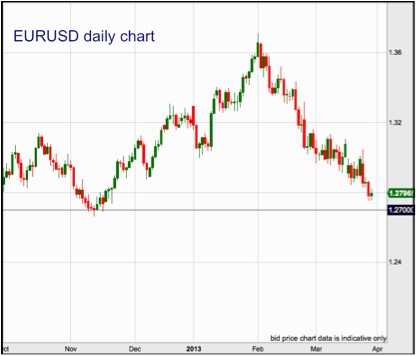 For many people, the Cyprus drama is over, but the repercussions of this will be bouncing around the markets for some time. It’s made many investors (and not just those in southern Europe) question their attitude to risk – and sent them looking for safer, and more profitable places for their money.
For many people, the Cyprus drama is over, but the repercussions of this will be bouncing around the markets for some time. It’s made many investors (and not just those in southern Europe) question their attitude to risk – and sent them looking for safer, and more profitable places for their money.
You probably know plenty of people who think that trading is a bit risky. But ask those same people where their money is, and they’ve probably no idea.
In the bank?
When you put your money in a savings account, the bank clerk doesn’t lock it in the safe at the back of the high-street branch until you want it out again. Of course not. They lend it out to other people. Often to people who aren’t expected to pay it back again for 25 years.
And yet, when we want to get our hands on it – we grumble if it takes more than a day to land in our pocket. We certainly wouldn’t take kindly to being told that we just need to wait 20-odd years until our next-door neighbour had finished paying off his mortgage.
This is the business of banks. And it can make the most boring, safe, high-street bank sound like a crazy, casino business.
And, bizarrely, in much of the Western world, it seems to have been working okay for years.
The glue that holds the whole process together is deposit insurance. The theory is that banks pay for deposit insurance, and a central body (the government) will step in, if necessary, to guarantee the savings of individuals.
There’s a limit to how much this insurance covers. In the Eurozone, it’s 100,000 euros. At least, that’s what everyone thought it was, until about 10 days ago.
In the middle of this month, the Cypriot parliament announced plans to take 6.7 per cent from every insured bank account (that’s the ones that are covered by the 100,000 deposit insurance). And 9.9 per cent from the uninsured accounts.
What has shocked so many savers is the mere idea that a government can even consider dipping into accounts below that insurance level.
These are the accounts that everyone believed were safe. Deposit insurance was considered, at least in the developed world, to be sacrosanct.
Suddenly deposit insurance doesn’t sound so safe.
Of course, Cyprus has the problem that it can’t turn to its national government for a bailout, because Cyprus doesn’t print its own money. Instead it has to beg for a handout from Europe. And we’ve heard no end of excuses about why Cyprus is a “special case”, but every country has its own special circumstances.
But when the Eurogroup president Jeroen Dijsselbloem described Cyprus as a “blueprint” for future bailouts this week, we saw widespread panic across the markets.
When it came to the crunch, the troika weren’t happy with the idea of levying insured bank accounts – it’s the kind of plan that could cause full-on runs on banks throughout the Eurozone. So the next plan was to place a higher levy on the uninsured accounts (those over 100,000 euros).
But that original plan for the 6.7 per cent tax on all accounts is still ringing in the ears of many savers.
And the who-knows-what levy on savers with more money in the bank, will have anyone with over 100,000 euros in a European bank feeling very nervous.
It’s like a huge infidelity hanging over the relationship between banks and customers, undermining the trust with which we hand over our money.
And on Wednesday this week, UK banks were told just how under-capitalized they were. So, just how safe do you feel that money in any European bank is?
So, what does it mean for traders?
There are two key lessons here for traders, and investors in general.
The first is to do with risk – we need to spread it, and be aware that options we thought of as zero-risk, are in fact nothing of the sort. Spread your capital among different investments with varying risk profiles.
The second is to do with the return of volatility…
Just when we felt it was safe to dip our toes into the Mediterranean again, that the Euro crisis was over – Cyprus happens. And markets are well and truly on the move.
For traders, this is no bad thing – as long as we’re well positioned.
Right now, the place that’s really got everyone’s attention is the US – economic results are positive… it has safe-haven status… everyone wants in.
US equities have barely flinched at the Cyprus crisis. The Dow Jones broke new highs earlier this month…

And the S&P is close to breaking its all-time high…

The problem we have with the rarified air on these charts is that we’re in (or moving into), quite literally, uncharted territory. And traders aren’t keen on uncharted waters.
First off, all those historical support and resistance levels that we like to draw on our charts – they aren’t there!
And secondly, there’s the fear of the correction. Astronomers know that the star that shines brightest will extinguish itself long before a cooler, darker star – so when we’ve had a meteoric rise, like that seen on the Dow, these trends simply aren’t sustainable. Eventually, we’ll get a pullback at worst, or a period of consolidation at best.
A trend that I’m considerably more excited about is the EURUSD. This currency pair has moved by over 7 per cent in two months. And, as you can see on this chart, it’s currently approaching a significant support level at 1.27

Over the coming weeks, I’ll be looking at some practical ways to play this pairing. And I expect that playing dollar strength on the forex markets is going to be a huge story for 2013.
